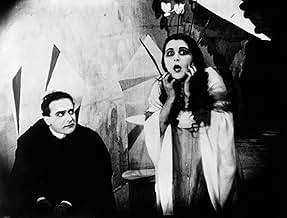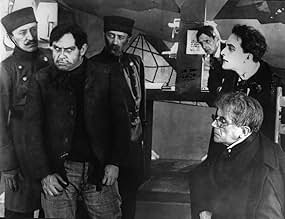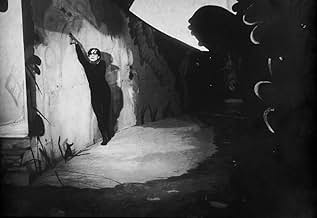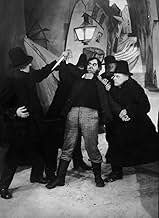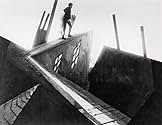IMDb रेटिंग
8.0/10
74 हज़ार
आपकी रेटिंग
कृत्रिम निद्रावस्था में लानेवाला डॉ कैलिगरी एक सोमनामबुलिस्ट, सीज़र का उपयोग करता है।कृत्रिम निद्रावस्था में लानेवाला डॉ कैलिगरी एक सोमनामबुलिस्ट, सीज़र का उपयोग करता है।कृत्रिम निद्रावस्था में लानेवाला डॉ कैलिगरी एक सोमनामबुलिस्ट, सीज़र का उपयोग करता है।
- पुरस्कार
- 2 जीत और कुल 1 नामांकन
Friedrich Feher
- Franzis
- (as Friedrich Fehér)
Hans Heinrich von Twardowski
- Alan
- (as Hans Heinz v. Twardowski)
Rudolf Lettinger
- Dr. Olsen
- (as Rudolph Lettinger)
Rudolf Klein-Rogge
- Ein Verbrecher
- (बिना क्रेडिट के)
- …
Hans Lanser-Ludolff
- Ein Alter Mann
- (बिना क्रेडिट के)
- …
Henri Peters-Arnolds
- Ein Junger Arzt
- (बिना क्रेडिट के)
- …
Ludwig Rex
- Ein Mörder
- (बिना क्रेडिट के)
- …
Elsa Wagner
- Die Wirtin
- (बिना क्रेडिट के)
- …
फ़ीचर्ड समीक्षाएं
Having only started discovering silent movies recently, I don't have more than a handful of other non-talkies to compare it to. This however was not only one of the best, most compelling and unique silents I have seen, but also a great flick overall. It's all been said before, I'm sure, but I'll say it again: this is a milestone of German Expressionist cinema. It is also a class-A mind-phuck movie (excuse my French), one of those stories that'll leave you eternally scratching your head trying to figure out what you've seen, what to believe and what can be a plausible explanation for most of the creepy mysteries you've just witnessed. Right from the very opening scene, seemingly suspended in an otherworldly dimension, maybe somewhere in between life and death, in which the first line spoken is: "There are spirits everywhere", you realise you are in for a spooky ride (this is the ultimate Halloween movie, come to think of it!) Having studied theatre set and costume design at Rome's art school for a year before going to university, I was obviously completely fascinated by the set design choices here. Buildings and furniture, props and painted backdrops are elongated and deformed into blocky, savage, expressionistic, perspective-defying and proportion-less forms. Even the intertitles weren't of the traditional sort. The result is obviously one of unsettling the viewer further into believing themselves suspended in a reality where anything could happen - anything horrible or nightmarish, obviously. Nothing is as it seems, right to the very end. Btw, on a more frivolous note, I thought the character of Cesare the Somnambulist looked uncannily like something that might have influenced Tim Burton into creating Edward Scissorhands, or maybe even more, the look of some of the characters in Rocky Horror Picture Show.
It struck me last night that I've never seen a serious silent film. Everyone's seen a silent comedy: Charlie Chaplin, Buster Keaton, the Keystone Cops... They've all been immortalized in the minds of every film viewer, and I enjoy them as much as anyone. But it seems a strange and almost disrespectful lack to never have seen anything but comedy; so many silent films were created, and the only ones I've seen starred waddling tramps.
It was partially for that reason that I rented this movie. I had read about it on a film review site (the name of which escapes my memory) and decided it was worth the half-hour drive to the video store. The basic premise is that of a man relating a story that happened to him and his friends - their unnerving discovery of a crazed mountebank, Dr. Caligari, and his prophetic sleepwalker. It follows a series of murders and growing madness, keeping you in constant suspense and confusion until the very last scene.
There's a period of adjustment when watching it - unfortunately necessary for a modern audience. The titles seem too slow. The camera seems to hold on scenes too long. The makeup on the actors' faces seem ghostly and horrible - even on the hero.
But before long, the movie has you in its grip. You spend time staring at the architecture - buildings, doors, and windows that would have been funny in a Dr. Seuss book. In the film, they make you uneasy. The whole atmosphere is of a world gone wrong; like a dream worthy of Salvador Dalí. Nothing is square or straight. The buildings loom in on you; windows sweep upward, slanted or curved; doors are obscenely angled holes beckoning you to enter and be trapped inside.
Throughout, the story defies expectations. Small plot twists confuse and mislead you until the final surprise, completely tearing down everything you thought the movie was about. Strange shadows and shots from inside alleys paint the film's world as something terrible, never allowing you a normal look at the village, never allowing you to enjoy the quaintness of it. Through it all, the grinning, hunched figure of Dr. Caligari hangs in your mind, pushing out rational thought.
The movie is well worth your time; there's a certain pleasure in trying to capture the feeling of terror an early audience, unaccustomed to the visual effects we see every day, would have had the first time they saw this movie. It's an intellectual terror in the grand old style, giving you the same thrill you get from reading Frankenstein or Dr. Jekyll and Mr. Hyde. At the risk of sounding cliché: two thumbs up!
It was partially for that reason that I rented this movie. I had read about it on a film review site (the name of which escapes my memory) and decided it was worth the half-hour drive to the video store. The basic premise is that of a man relating a story that happened to him and his friends - their unnerving discovery of a crazed mountebank, Dr. Caligari, and his prophetic sleepwalker. It follows a series of murders and growing madness, keeping you in constant suspense and confusion until the very last scene.
There's a period of adjustment when watching it - unfortunately necessary for a modern audience. The titles seem too slow. The camera seems to hold on scenes too long. The makeup on the actors' faces seem ghostly and horrible - even on the hero.
But before long, the movie has you in its grip. You spend time staring at the architecture - buildings, doors, and windows that would have been funny in a Dr. Seuss book. In the film, they make you uneasy. The whole atmosphere is of a world gone wrong; like a dream worthy of Salvador Dalí. Nothing is square or straight. The buildings loom in on you; windows sweep upward, slanted or curved; doors are obscenely angled holes beckoning you to enter and be trapped inside.
Throughout, the story defies expectations. Small plot twists confuse and mislead you until the final surprise, completely tearing down everything you thought the movie was about. Strange shadows and shots from inside alleys paint the film's world as something terrible, never allowing you a normal look at the village, never allowing you to enjoy the quaintness of it. Through it all, the grinning, hunched figure of Dr. Caligari hangs in your mind, pushing out rational thought.
The movie is well worth your time; there's a certain pleasure in trying to capture the feeling of terror an early audience, unaccustomed to the visual effects we see every day, would have had the first time they saw this movie. It's an intellectual terror in the grand old style, giving you the same thrill you get from reading Frankenstein or Dr. Jekyll and Mr. Hyde. At the risk of sounding cliché: two thumbs up!
This movie was shot between 1919 and 1920, a few decades since the motion picture camera was invented, and the Lumière brothers were in the middle of their experiments with it. At the time, cinema was being considered as a new way of making art, and yo make art you had to marry with a serie of ideas: ideology, aesthetics, cosmogony, etc. In these terms, this movie belongs to the German expressionism, which is reflected in the entire setup: from characters make up to the background of the set.
Having an average murder-mystery plot, the movie can be defined as a painting with some action occurring in it. The whole scenario was displayed following the same criteria as in expressionist painting: all diagonal and curve lines, evading the straightness and the cardinal orientation of things, wicked perspectives and proportions. Even the more minimum detail was carefully considered to fulfill the aesthetics needs. The result couldn't have been better, considering that the only visual trick they could do was to shrink/enlarge the camera's diafragma. Think that this was before the concept of travelling was even developed.
Concerning the plot, yet it's true that it isn't really the great thing and that many people now a days find it boring, I got to enjoy it, further than its aesthetical function (I even got to laugh in a couple of scenes), and I highly recommend it, as a good old piece of art from which many of today's film makers may take some good lessons on how to approach movies. I'm sure that if they got understand that, then there would be much lesser crappy movies than there are now a days.
Having an average murder-mystery plot, the movie can be defined as a painting with some action occurring in it. The whole scenario was displayed following the same criteria as in expressionist painting: all diagonal and curve lines, evading the straightness and the cardinal orientation of things, wicked perspectives and proportions. Even the more minimum detail was carefully considered to fulfill the aesthetics needs. The result couldn't have been better, considering that the only visual trick they could do was to shrink/enlarge the camera's diafragma. Think that this was before the concept of travelling was even developed.
Concerning the plot, yet it's true that it isn't really the great thing and that many people now a days find it boring, I got to enjoy it, further than its aesthetical function (I even got to laugh in a couple of scenes), and I highly recommend it, as a good old piece of art from which many of today's film makers may take some good lessons on how to approach movies. I'm sure that if they got understand that, then there would be much lesser crappy movies than there are now a days.
10Gafke
Made in 1919, "The Cabinet of Doctor Caligari" was literally years ahead of its time and remains a triumphant accomplishment in the genre of German Expressionism. Remembered mainly for its stunning sets, which featured crooked buildings and twisted landscapes, "Cabinet" also boasts one of the first attempts at a twist ending, something quite new and shocking for its time.
Told mainly from the point of view of Francis, a young man who lives in the small village of Holstenwall, Germany, "Cabinet" tells the tale of murder and madness which seems to accompany the arrival of a carnival. Francis and his best friend Alan go to the carnival and are presented with the sideshow attraction Cesare the Somnambulist, a gaunt and hideous young man who spends his life sleeping in a coffin-like cabinet and seems able to predict the future when awake. Cesare (played by a young Conrad Veidt, who later went on to play the evil Nazi general in Casablanca) informs Alan that he will soon die, and indeed, Alan is found murdered the next morning. Suspicion turns to the eerie somnambulist and his strange keeper, a man called Caligari. As Francis desperately tries to solve the mystery and find his friends killer, it seems that the beautiful young Jane, beloved by both Alan and Francis, has been targeted as the next victim.
This is a genuinely creepy film which delves deep into the mysteries of the abnormal mind...an uncomfortable journey to say the least. Everyone is suspect and, in the end, we must ask ourselves: "who is really the mad one here?"
Subtle and ingenious, we see the world the way an insane person might see it; warped and confused, a nightmarish terrain where nothing makes sense and balance is not to be found.
The impact of this film is still being felt and seen today, and for good reason. It is a shocking, disturbing masterpiece. I cannot recommend it highly enough.
Told mainly from the point of view of Francis, a young man who lives in the small village of Holstenwall, Germany, "Cabinet" tells the tale of murder and madness which seems to accompany the arrival of a carnival. Francis and his best friend Alan go to the carnival and are presented with the sideshow attraction Cesare the Somnambulist, a gaunt and hideous young man who spends his life sleeping in a coffin-like cabinet and seems able to predict the future when awake. Cesare (played by a young Conrad Veidt, who later went on to play the evil Nazi general in Casablanca) informs Alan that he will soon die, and indeed, Alan is found murdered the next morning. Suspicion turns to the eerie somnambulist and his strange keeper, a man called Caligari. As Francis desperately tries to solve the mystery and find his friends killer, it seems that the beautiful young Jane, beloved by both Alan and Francis, has been targeted as the next victim.
This is a genuinely creepy film which delves deep into the mysteries of the abnormal mind...an uncomfortable journey to say the least. Everyone is suspect and, in the end, we must ask ourselves: "who is really the mad one here?"
Subtle and ingenious, we see the world the way an insane person might see it; warped and confused, a nightmarish terrain where nothing makes sense and balance is not to be found.
The impact of this film is still being felt and seen today, and for good reason. It is a shocking, disturbing masterpiece. I cannot recommend it highly enough.
"The Cabinet of Dr Caligari" is upheld as one of cinema's greats, and in a number of regards, I can understand why. It is hauntingly beautiful and wonderfully stylised. It's Expressionistic cinematography is wonderful and suspenseful; it's no wonder that this film has influenced many subsequent directors and producers many years later.
However, whilst it surely wouldn't have seemed like this back in 1920, it is rather boring through contemporary eyes. I'm sorry if this makes me sound ignorant, but today it plays rather slow-paced and un-scary, even compared to some of the other greats of Weimar cinema (such as "Nosferatu").
Not a bad film by any means (I would recommend it), but "Caligari" seems more something of historical value and academic study to me.
However, whilst it surely wouldn't have seemed like this back in 1920, it is rather boring through contemporary eyes. I'm sorry if this makes me sound ignorant, but today it plays rather slow-paced and un-scary, even compared to some of the other greats of Weimar cinema (such as "Nosferatu").
Not a bad film by any means (I would recommend it), but "Caligari" seems more something of historical value and academic study to me.
क्या आपको पता है
- ट्रिवियाWriter Hans Janowitz claims to have gotten the idea for the film when he was at a carnival one day. He saw a strange man lurking in the shadows. The next day he heard that a girl was brutally murdered there. He went to the funeral and saw the same man lurking around. He had no proof that the strange man was the murderer, but he fleshed the whole idea out into his film.
- गूफ़In the wide shot, the sign at the asylum reads "Insane Asylum," in English. In the close-up, the sign is written in German (Kino Blu-ray Disc version, may not be present in all editions of the film).
- इसके अलावा अन्य वर्जनUSA laserdisc reissue restores the original hand-drawn title cards that have been missing from every known print of the film since 1923. When first released on video in the United States, film was in black-and-white, and played back many scenes at double speed and featured different music. Although no scenes were cut out, the running time was reduced to only 51 minutes. The restored version restores the colour-tinting, restores the original title cards, and plays the film back at regular speed, returning the film to its original 69-minute running time.
- कनेक्शनEdited into People Who Die Mysteriously in Their Sleep (2004)
टॉप पसंद
रेटिंग देने के लिए साइन-इन करें और वैयक्तिकृत सुझावों के लिए वॉचलिस्ट करें
विवरण
- रिलीज़ की तारीख़
- कंट्री ऑफ़ ओरिजिन
- भाषा
- इस रूप में भी जाना जाता है
- El gabinete del Dr. Caligari
- फ़िल्माने की जगहें
- उत्पादन कंपनी
- IMDbPro पर और कंपनी क्रेडिट देखें
बॉक्स ऑफ़िस
- बजट
- $18,000(अनुमानित)
- US और कनाडा में सकल
- $8,811
- दुनिया भर में सकल
- $9,297
- चलने की अवधि1 घंटा 16 मिनट
- ध्वनि मिश्रण
- पक्ष अनुपात
- 1.37 : 1
इस पेज में योगदान दें
किसी बदलाव का सुझाव दें या अनुपलब्ध कॉन्टेंट जोड़ें

टॉप गैप
By what name was Das Cabinet des Dr. Caligari (1920) officially released in India in English?
जवाब

